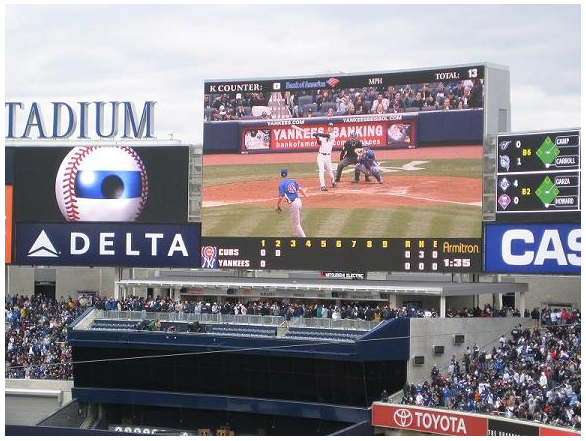Cisco Executes Its Stadium Vision, Monitors to Mobile Gadgets
(SPORTS TECHNOLOGY)
Now that baseball season’s upon us, I’m itching to go to my first New York Yankees game.
Still, it’s annoying that most of the time I go to a game – unless we’re sitting three rows behind first base or watching HDTV – I can barely see the batter’s box. And given the new, “upscale” prices of Yankees tickets (though not as bad as Cubs or Red Sox tickets, I hear), the prospect of trekking to the new Yankee Stadium just makes me want to sit on my couch instead, where I can see every crinkle on Derek Jeter’s face or stare back at C.C. Sabathia.
So when first heard about Cisco’s (News - Alert) big plans to personalize sports entertainment for the next-generation fan, I was psyched. Cisco is enhancing the game-day experience for fans at stadiums in totally new ways – and it doesn’t even have to offer $18 sushi rolls.
The networking giant known for its routers is now making monitors designed for sports stadiums. Eventually, the technology it’s using for these monitors will channel more personalized content to mobile devices like the iPad.
Earlier this week I sat down for a chat – via a freakishly cool telepresence set-up – with Dave Holland, senior vice president and general manager of Cisco Sports, to learn more about Cisco StadiumVision. The first 1,000 ‘StadiumVision’ monitors were installed last year, christening the new Yankees Stadium. Other installations followed, for the Kansas City Royals, Miami Dolphins and Dallas Cowboys in their stadiums.
According to Holland, StadiumVision helps to provide fans with a more interactive and personalized game experience: In addition to watching live game footage via the monitors through the stadium, fans will soon have the power of IT administrators working the monitors. They’ll be able to “adapt” the technology to their needs by changing the camera angles, showing replays, finding scores of other games, looking up weather conditions and team statistics, and researching various stadium menus.
 So, for example, if you’re hosting a party in the luxury suite for advertisers of a particular brand, monitors can be tailored to that brand’s advertising. When the games are over, these monitors allow fans to find the nearest exits while providing up-to-the-moment traffic information.
So, for example, if you’re hosting a party in the luxury suite for advertisers of a particular brand, monitors can be tailored to that brand’s advertising. When the games are over, these monitors allow fans to find the nearest exits while providing up-to-the-moment traffic information.
“The whole strategy that Cisco is pursuing is to bring network relevance to sports entertainment … high-quality HD video to all the way down to handsets,” Holland told me.
Fair enough. So the bigger question is, how can you monetize that?
“Today, the StadiumVision solution that we have is [limited to] fixed screens -- on the concourses and the suites. And soon, we’ll be able to leverage that over to the handset,” he said. “So the same controlled video is running on voice, data and video … so you could have a Derek Jeter channel.”
Right now, said Holland, sports fans are “spoon fed” content at stadiums, but when they’re home watching TV, they have more flexibility.
It’s definitely a valid point. For those of use who only got acquainted with HDTV and the Internet in adulthood, spoon-fed content is something we’ve grown accustomed to.
Though no technology that can actually replace the experience of going to a game, Cisco’s bet that the “killer app” of video will fuel the next big thing in mobility (and sports) definitely makes sense, given the super-high-quality digital experience most preteens have never gone without.
Thus, it’s no surprise that Cisco’s in talks with “many venues in North America.”
“We believe that the next generation fan will demand an experience that is different that what I demanded,” Holland told me. “We have to think differently about how sports franchises are delivering that content -- how are they capturing that content in a way that captures the next-generation fan.”
Marisa Torrieri is a TMCnet Web editor, covering IP hardware and mobility, including IP phones, smartphones, fixed-mobile convergence and satellite technology. She also compiles and regularly contributes to TMCnet's gadgets and satellite e-Newsletters. To read more of Marisa's articles, please visit her columnist page.
Edited by Michael Dinan


